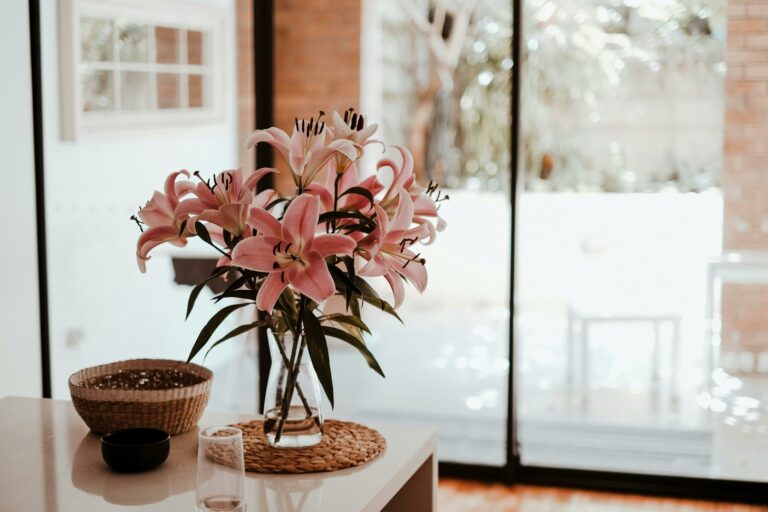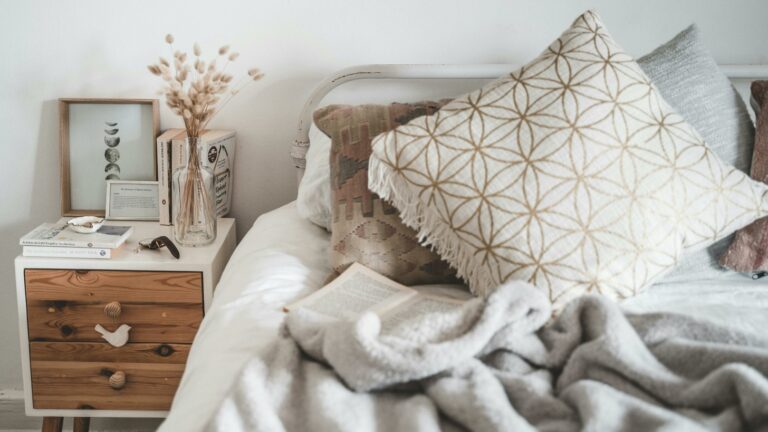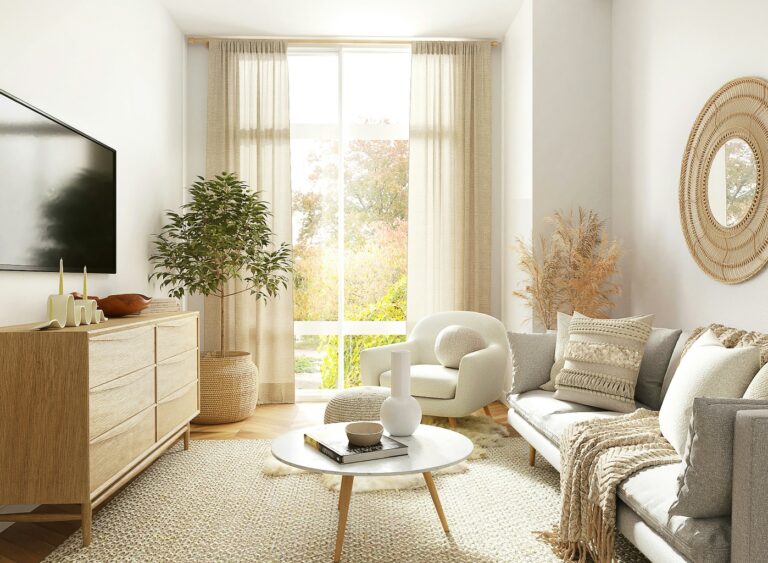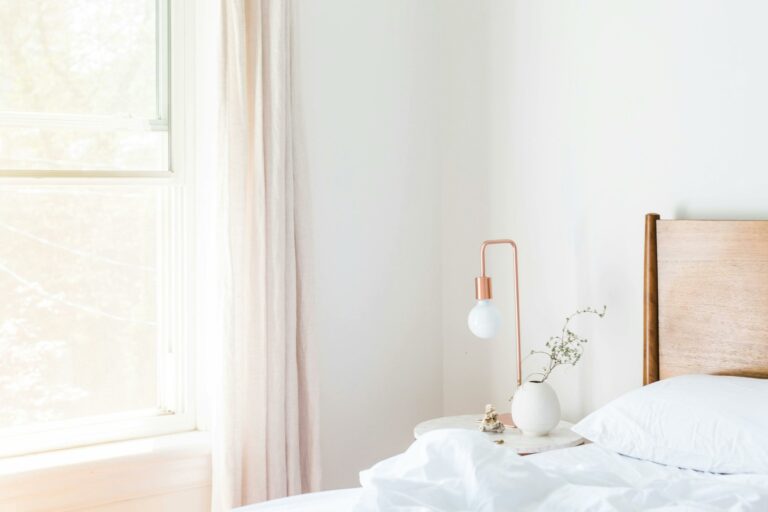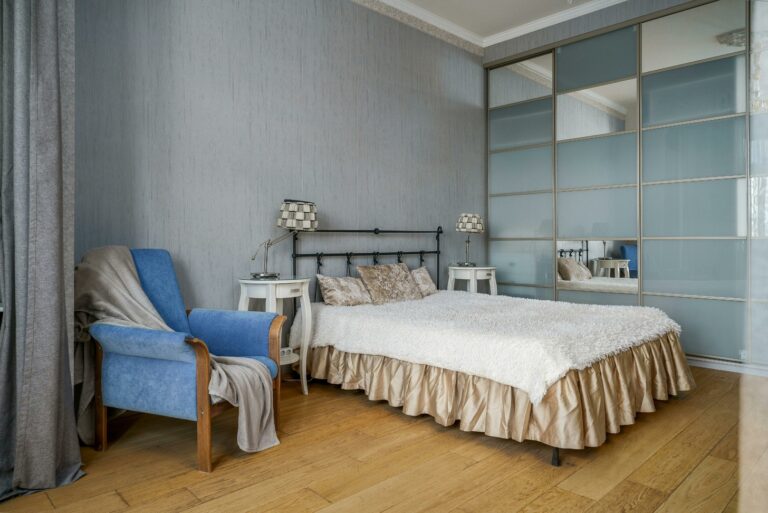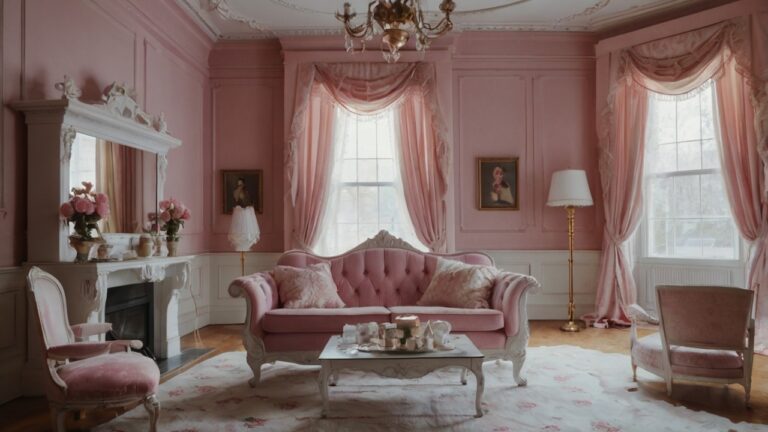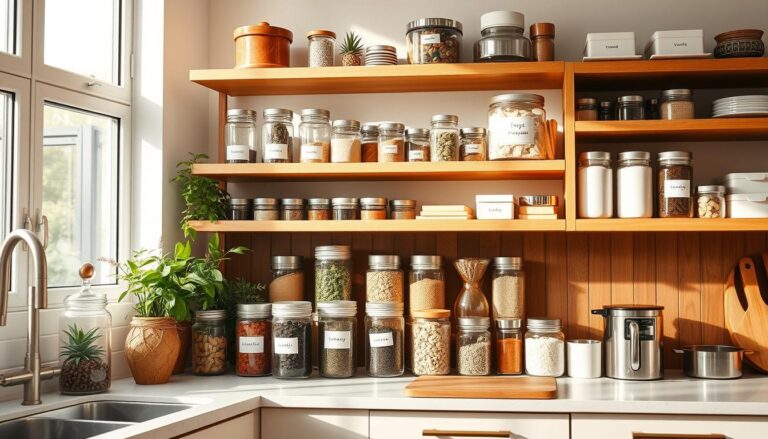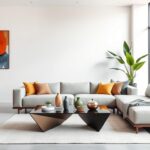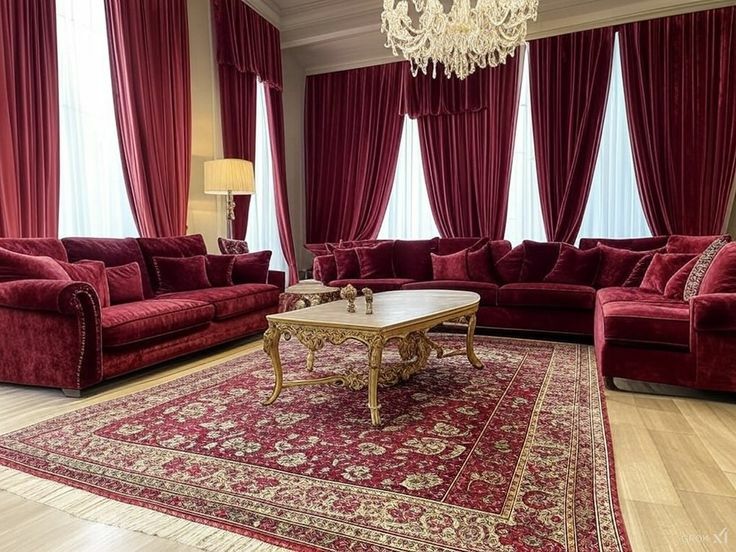
Have you ever walked into a room and felt an instant shift in your mood? The walls, furniture, and decor all play a role in creating an atmosphere, but one element stands out: color. The colors surrounding us in our daily lives can significantly influence our emotions, energy, and overall well-being.
The concept of home color psychology suggests that the colors we choose for our living spaces are not just aesthetically pleasing but also have a profound psychological impact. From calming blues to energizing yellows, the right color palette can transform a house into a home that nurtures both body and mind.
Key Takeaways
- The psychological impact of colors on mood and energy
- How different colors influence occupants’ well-being
- Tips for choosing the right color palette for your home
- The role of color in creating a harmonious living space
- Examples of colors that can boost or drain energy
The Science Behind Color Psychology
The impact of colors on our psyche is a fascinating area of study that blends psychology, neuroscience, and design. Colors are not just a matter of personal preference; they have a profound effect on our emotions, actions, and physiological responses. Understanding the science behind color psychology can help us make informed decisions about the colors we choose for our homes.
How Colors Affect Brain Chemistry
Colors influence our brain chemistry in various ways, primarily through the wavelengths of light they reflect. Different wavelengths affect the brain differently, triggering various neural responses.
Light Wavelengths and Neural Responses
When light enters our eyes, it stimulates the retina, which sends signals to the brain. Different wavelengths correspond to different colors, and these colors can stimulate or calm the brain. For instance, shorter wavelengths like blue and violet can be stimulating, while longer wavelengths like red and orange can be more calming.
Color-Induced Hormonal Changes
Colors can also induce hormonal changes in our body. For example, exposure to red light can increase heart rate and stimulate the production of adrenaline, while blue light can affect our circadian rhythms by influencing melatonin production.
The Evolution of Color Perception
Our perception of colors has evolved over time, influenced by both biological and cultural factors. Understanding this evolution can provide insights into why certain colors affect us the way they do.
Biological Significance of Color Recognition
Color recognition has significant biological importance. For example, the ability to distinguish between ripe and unripe fruit, or to recognize the color changes in a potential mate, has evolutionary advantages. This biological significance is deeply rooted in our brain’s wiring.
| Color | Wavelength | Effect on Human Body |
|---|---|---|
| Red | 620-750nm | Increases heart rate and stimulates adrenaline production |
| Blue | 450-495nm | Affects circadian rhythms and can be calming |
| Green | 520-560nm | Can reduce eye fatigue and improve vision |
By understanding the science behind color psychology, we can harness the power of colors to create living spaces that are not only aesthetically pleasing but also beneficial for our well-being.
How Can Your Home's Colors Affect You?
The colors you choose for your home can have a profound impact on both your physical and emotional well-being. The right palette can enhance your mood, improve your sleep, and even affect your appetite and energy levels.
Physical Responses to Different Colors
Colors can influence various physiological responses. For instance, certain hues can affect your heart rate and blood pressure.
Impact on Blood Pressure and Heart Rate
Studies have shown that exposure to certain colors can alter your heart rate and blood pressure. For example, the color red is known to stimulate the body, potentially increasing heart rate and blood pressure. On the other hand, cooler colors like blue can have a calming effect, reducing these physiological measures.
Effects on Sleep and Circadian Rhythms
The colors used in bedrooms can significantly impact sleep quality. Cool, muted tones such as light blue or pale green can promote better sleep by creating a calming environment. Avoiding bright, stimulating colors like red or orange in bedrooms can help regulate circadian rhythms.
Emotional and Psychological Impacts
Beyond physical effects, home colors also have profound emotional and psychological impacts. The right colors can enhance your mood, improve cognitive function, and even influence your productivity.
Mood Enhancement and Regulation
Colors like yellow and orange are known to boost mood and energy. Yellow, in particular, is associated with feelings of happiness and warmth. However, it’s essential to use these colors in moderation to avoid overwhelming the senses.
Cognitive Performance and Focus
Certain colors can improve concentration and cognitive performance. Blue, for instance, is often cited as a productive color, enhancing focus and mental clarity. This makes it an excellent choice for home offices or study areas.
When choosing paint colors for home, consider the function of each room and the emotions you want to evoke. By selecting colors that align with the purpose of each space, you can create a more harmonious and supportive living environment.
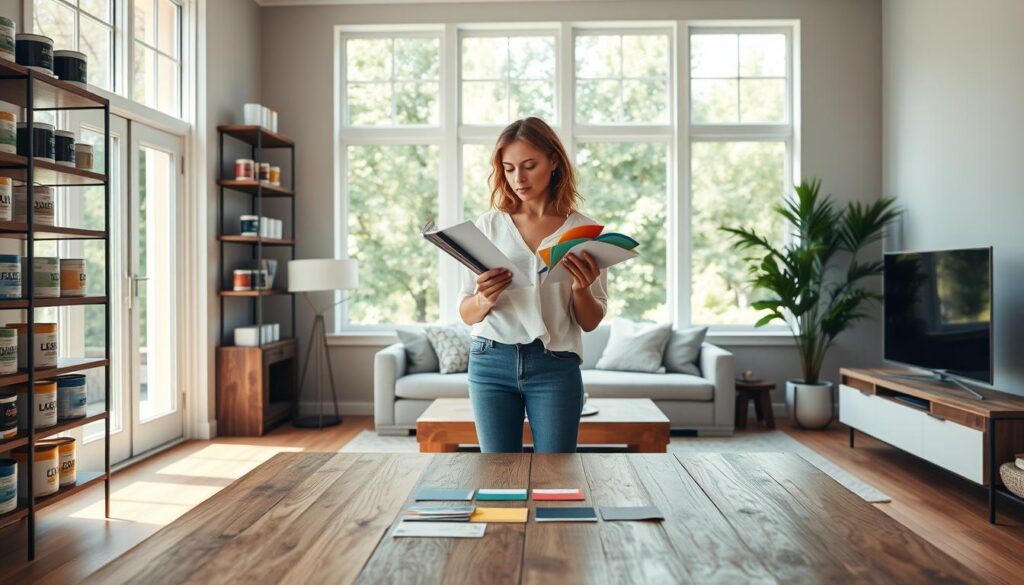
- Consider the natural light in each room when selecting colors.
- Test paint samples on walls before committing to a specific shade.
- Think about the emotional effects of different colors on occupants.
Warm Colors: Energizing Your Living Space
Incorporating warm colors into your home decor can boost your energy and enhance your overall well-being. Warm colors are known to stimulate emotions and create a cozy ambiance in your living space. Let’s explore how you can use red, orange, and yellow to energize your home.
Red: Passion, Energy, and Appetite
Red is a powerful color that can evoke feelings of passion and energy. It’s also known to stimulate appetite, making it a popular choice for dining areas. Using red accents in your kitchen or dining room can create a warm and inviting atmosphere, perfect for family gatherings and dinner parties.
Best Rooms for Red Accents
While red can be overwhelming if used excessively, strategic accents can add a pop of color to any room. Consider using red in:
- Living rooms to create a cozy and energetic vibe
- Dining rooms to stimulate appetite and conversation
- Kitchens as an accent color for cabinets or accessories
Orange: Creativity and Enthusiasm
Orange is a vibrant color that can inspire creativity and enthusiasm. It’s an excellent choice for spaces where you want to encourage activity and interaction. Orange can add a fun and youthful touch to your home decor, making it ideal for playrooms or home gyms.
Using Orange to Stimulate Conversation
Orange can be used effectively in social areas to stimulate conversation and create a lively atmosphere. Consider incorporating orange through throw pillows, blankets, or wall art in your living room or family room.
Yellow: Optimism and Mental Stimulation
Yellow is a bright and cheerful color that can promote optimism and mental stimulation. It’s an excellent choice for home offices or study areas where you need to stay focused and energized. Yellow can help improve your mood and productivity, making it a great addition to any room.
Balancing Yellow's Intensity
While yellow can be uplifting, it can also be overwhelming if used too liberally. To balance its intensity, consider pairing yellow with neutral colors like white or gray. This can help create a harmonious and inviting atmosphere in your home.
Cool Colors: Creating Calm and Focus
Cool colors, including blues, greens, and purples, are known to have a soothing impact on both the mind and body. These colors can play a crucial role in creating a calming home environment that promotes relaxation and mental clarity.
Blue: Tranquility and Productivity
Blue is often associated with feelings of tranquility and trust. It can help in reducing stress and improving productivity, making it an ideal color for bedrooms and home offices.
Different Blues for Different Moods
From light sky blue to deep navy, the various shades of blue can evoke different emotions. Lighter blues can create a sense of calmness, while darker blues can add a sense of sophistication and professionalism.
Green: Balance and Renewal
Green represents balance and renewal, bringing a sense of harmony to a space. It’s known to have a calming effect and can help in reducing eye strain, making it perfect for living areas and reading nooks.
Bringing Nature Indoors Through Green
Incorporating green into your home decor can be as simple as adding plants or using green accents. This can help in creating a natural and calming atmosphere, reminiscent of the outdoors.
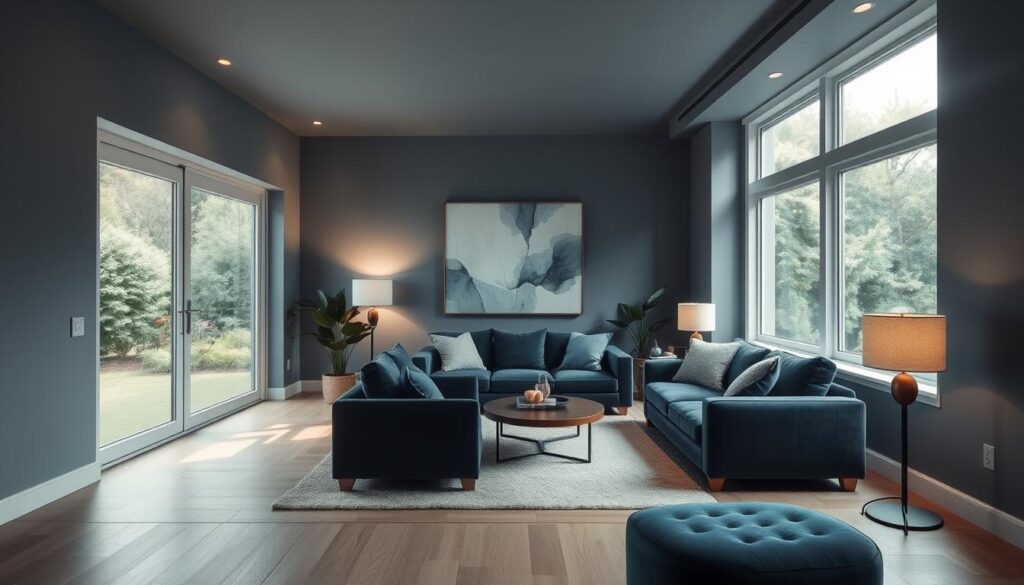
Purple: Luxury and Contemplation
Purple is associated with luxury, creativity, and wisdom. It can add a touch of sophistication to any room, making it ideal for spaces where you want to encourage contemplation and creativity.
Creating Sophisticated Spaces with Purple
Using purple in your home decor can range from subtle accents to bold statements. Lighter purples can create a sense of romance, while deeper purples can add luxury and grandeur.
By understanding the psychology of interior design colors, you can make informed decisions about the color scheme of your home, creating spaces that are not only aesthetically pleasing but also conducive to your well-being.
Neutral Colors: The Foundation of Home Design
When it comes to home design, neutral colors are the unsung heroes, offering a balanced and sophisticated aesthetic. Neutral tones provide a versatile backdrop that can be personalized with furniture, artwork, and decorative elements.
White: Purity and Spaciousness
White is a popular neutral color that can make rooms appear larger and more spacious. It reflects light, creating a bright and airy feel.
Choosing the Right White for Your Space
With various shades of white available, selecting the right one can be challenging. Consider the undertones of other colors in your decor to ensure harmony. Warm whites have a yellow or beige undertone, while cool whites have a blue or pink undertone.
Gray: Sophistication and Versatility
Gray is another versatile neutral color that can add sophistication to any room. It comes in a range of shades, from light to dark, allowing for flexibility in design.
Warm vs. Cool Grays in Home Design
Like whites, grays also have undertones that can affect the ambiance of a room. Warm grays have a brown or beige undertone, creating a cozy atmosphere, while cool grays have a blue undertone, producing a calming effect.
Brown and Beige: Grounding and Comfort
Brown and beige are earthy neutral colors that can bring warmth and comfort to a space. They are ideal for creating a cozy and inviting atmosphere.
Creating Cozy Environments with Earth Tones
Earth tones like brown and beige can be used to create a sense of grounding. They work well with natural materials like wood and stone, enhancing the organic feel of a room.
By incorporating these neutral colors into your home design, you can create a balanced and harmonious space that reflects your personal style. Whether you’re looking to renovate or simply refresh your decor, neutral colors provide a timeless foundation.
Room-by-Room Color Strategy
To create a cohesive and inviting home, it’s vital to tailor your color choices to the specific purpose and characteristics of each room. Different spaces within your home serve different functions, and the right colors can enhance these functions, improving both the aesthetic appeal and the livability of your home.
Bedrooms: Colors for Rest and Intimacy
The bedroom is a sanctuary where you rest and recharge. Colors that promote relaxation and serenity are ideal. Soft blues, gentle greens, and muted grays can create a calming atmosphere.
Children's vs. Adult Bedrooms
For children’s bedrooms, consider colors that stimulate imagination and energy, such as soft yellows or playful pinks. Adult bedrooms, on the other hand, often benefit from more subdued tones that encourage relaxation.
Living Areas: Colors for Socializing and Relaxation
Living areas are where families gather and socialize. Warm, inviting colors like beiges, taupes, and soft oranges can create a welcoming atmosphere. For more formal living rooms, consider deeper, richer colors.
Open Floor Plans and Color Transitions
In homes with open floor plans, it’s essential to choose colors that flow smoothly from one area to another. Using a unifying color scheme or gradual transitions between colors can help maintain visual harmony.
Kitchens: Colors for Appetite and Energy
Kitchens are not just for cooking; they’re often the heart of the home. Colors that stimulate appetite and energy, such as warm reds and vibrant oranges, can be particularly effective.
Balancing Function and Aesthetics
While choosing colors for the kitchen, it’s crucial to balance functionality with aesthetics. Bright colors can be energizing, but they should be balanced with neutral tones to avoid overwhelming the space.
Home Offices: Colors for Focus and Productivity
For home offices, colors that enhance focus and productivity are key. Blues and greens are often recommended as they can improve concentration and mental clarity.
Reducing Eye Strain Through Color Choice
To reduce eye strain in home offices, consider using colors that are easy on the eyes. Soft grays, gentle blues, or muted greens can help create a comfortable working environment.
By carefully selecting colors for each room based on its function and your personal preferences, you can create a home that is both beautiful and functional.
Creating a Calming Home Environment with Colors
By understanding how different colors affect us, you can create a home environment that fosters calmness and serenity. The right color scheme can significantly impact our mood and well-being, making it a crucial element in home design.
Color Combinations for Stress Reduction
Certain color combinations can help reduce stress and promote relaxation. For instance, pairing soft blues with creamy whites can create a soothing atmosphere. Monochromatic color schemes can also be effective, as they create a sense of continuity and calm.
The Psychology of Color Layering
Layering different colors can add depth and interest to a room while maintaining a calming effect. This can be achieved by combining different shades of a single color or by mixing complementary colors. The key is to create a harmonious balance that promotes relaxation.
Using Color to Define Spaces and Purposes
Colors can be used to define different spaces within a home and to indicate their purpose. For example, calming colors like light green or sky blue can be used in bedrooms to promote rest, while more vibrant colors can be used in living areas to encourage social interaction.
Transitional Colors Between Rooms
Using transitional colors between rooms can help create a sense of flow and continuity. This can be particularly useful in open-plan homes where different areas are not separated by walls. Choosing colors that complement each other can enhance the sense of harmony and calm.
Seasonal Color Adjustments for Well-being
Adjusting your color scheme seasonally can also contribute to well-being. For example, warmer colors can be used in winter to create a cozy atmosphere, while cooler colors can be used in summer to promote a refreshing feel.
Light Therapy Through Color Selection
Certain colors can be used to simulate light therapy, which can be particularly beneficial during the winter months when natural light is scarce. Using colors that mimic natural daylight can help regulate mood and circadian rhythms.
Practical Tips for Implementing Color Psychology at Home
Creating a harmonious and functional home environment through color psychology is easier than you think. By applying a few simple principles, you can transform your living space into a haven that not only looks beautiful but also supports your well-being.
The 60-30-10 Rule for Color Balance
The 60-30-10 rule is a classic design principle that can help you achieve color balance in your home. This rule suggests that 60% of the room should be a dominant color, 30% a secondary color, and 10% an accent color.
Primary, Secondary, and Accent Colors
Understanding the roles of primary, secondary, and accent colors is crucial. The dominant color (60%) sets the overall tone, the secondary color (30%) adds depth, and the accent color (10%) creates visual interest.
Testing Colors Before Committing
Before painting an entire room, it’s essential to test the colors. This can save you from potential regrets and ensure the chosen color works well in different lighting conditions.
Sample Boards and Digital Visualization Tools
Using sample boards or digital visualization tools can give you a better idea of how the color will look. These tools allow you to see the color in your space before making a final decision.
Using Accent Colors for Flexibility
Accent colors offer a great way to add personality to your space and can be easily changed with the seasons or your mood.
Seasonal Updates Through Accessories
Updating your accent colors seasonally through accessories like throw pillows, blankets, or vases can keep your space feeling fresh and current.
Considering Natural and Artificial Lighting
Lighting can dramatically affect how colors appear in your home. Both natural and artificial lighting play significant roles in color perception.
How Light Sources Transform Color Perception
Natural light changes throughout the day, and artificial lighting can have different color temperatures. Understanding how these light sources interact with your chosen colors is key to achieving the desired effect.
By implementing these practical tips, you can effectively use color psychology to create a home environment that is both aesthetically pleasing and supportive of your mental and emotional well-being.
Conclusion: Creating Your Personal Color Harmony
As we’ve explored, the colors in your home play a significant role in shaping your mood and overall well-being. Understanding the principles of home color psychology can help you create a space that not only looks beautiful but also supports your emotional and psychological health.
By considering the color impact on mood, you can make informed decisions about the hues that will dominate your living areas, bedrooms, and workspaces. Whether you’re looking to energize a room with warm tones or create a calming atmosphere with cool colors, the right color palette can make all the difference.
As you embark on selecting colors for your home, remember that personal color harmony is about finding a balance that reflects your personality and meets your needs. Experiment with different shades, consider the natural and artificial lighting, and don’t be afraid to try out new combinations.
By applying the insights from color psychology, you can craft a living environment that is not only aesthetically pleasing but also nurturing and supportive. So, take the first step towards creating your personal color harmony and discover how the right colors can enhance your life.
FAQ
How do home colors affect my mood and energy?
Home colors can significantly impact your mood and energy levels. Different colors can stimulate or calm your mind and body, influencing your overall well-being. For example, warm colors like red and orange can boost energy and stimulate creativity, while cool colors like blue and green can promote relaxation and calmness.
What is the psychology behind choosing paint colors for my home?
The psychology behind choosing paint colors involves understanding how different colors affect human emotions and behavior. Color psychology suggests that certain colors can evoke specific emotional responses, such as feelings of calmness, energy, or happiness. By selecting colors that align with the intended use of each room, you can create a harmonious and functional living space.
How can I create a calming home environment with colors?
To create a calming home environment, focus on using cool, soothing colors like blues, greens, and neutral tones. These colors can help reduce stress and promote relaxation. You can also use color layering techniques and consider the 60-30-10 rule to achieve a balanced color scheme that fosters calmness.
What are some practical tips for implementing color psychology at home?
Some practical tips include using the 60-30-10 rule to balance your color scheme, testing colors with sample boards or digital visualization tools, and considering the impact of natural and artificial lighting on color perception. You can also use accent colors to add flexibility and update your space seasonally.
How do I choose the right colors for different rooms in my home?
When choosing colors for different rooms, consider the specific needs and functions of each space. For example, bedrooms benefit from calming colors like blues and greens, while kitchens and home offices may require more energizing colors like yellows and oranges. You can also use color to define spaces and purposes within open floor plans.
Can colors really impact my sleep and circadian rhythms?
Yes, colors can impact your sleep and circadian rhythms. Exposure to certain colors, especially in the evening, can affect your body’s internal clock and sleep quality. For instance, blue light from screens can suppress melatonin production, while warm, calming colors in the bedroom can promote better sleep.
How can I use color to enhance my productivity and focus?
To enhance productivity and focus, use colors that stimulate the mind, such as yellows, oranges, and greens. These colors can be particularly effective in home offices and study areas. Additionally, consider using accent colors to add visual interest and create a motivating environment.

